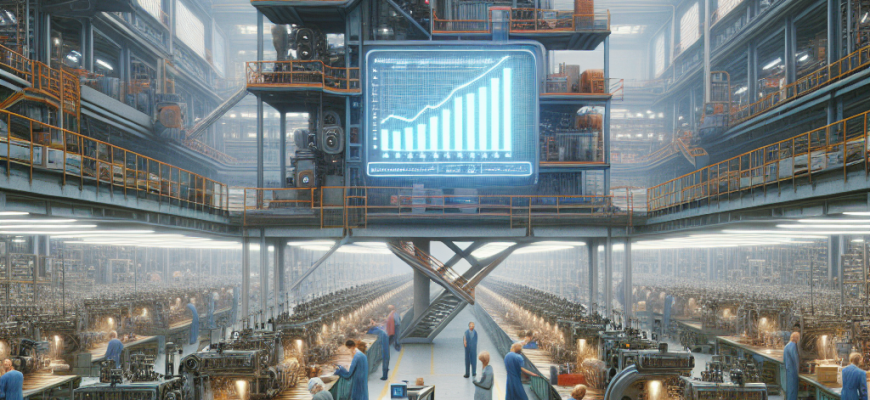<h1>Germany Faces Economic Slowdown as Factory Orders Decline</h1>
<h2>Overview of the Economic Situation</h2>
<p>Ah, my dear friends, Germany—once the beating heart of European economic strength—now finds itself in a rather precarious position. Like an aging rock star whose greatest hits are behind them, the German economy is grappling with a substantial slowdown, accentuated by a noticeable decline in factory orders and the ominous shadow of recession looming ever closer.</p>
<p>As per the latest forecasts, the German economy is predicted to shrink by 0.2% in 2024, following a 0.3% dip in 2023. Yes, you heard it right—this makes it the only G7 economy expected to contract this year. This somber prognosis is simply a continuation of the country’s long-standing structural challenges, and, if we’re honest, it feels like we’re watching a slow-motion train wreck.</p>
<h2>Decline in Factory Orders</h2>
<p>The latest statistics from the Federal Statistical Office, fondly known as <a href="https://www.destatis.de/EN/Home/_node.html">Destatis</a>, paint a rather dire picture: new manufacturing orders suffered a sharp decline in October 2024.</p>
<p>New manufacturing orders plummeted by 1.5% month-on-month in October, a staggering reversal from a robust 7.2% growth in September. What’s behind this dramatic shift, you ask? It’s primarily attributable to significant downturns in the production of machinery and equipment, which saw a jaw-dropping decline of 7.6%, and the automotive sector, which faced a less catastrophic—but still troubling—drop of 3.7%.</p>
<h2>Sector-Specific Challenges</h2>
<p>But wait, my friends, it’s not all doom and gloom. Like a fine wine, some sectors have managed to maintain their bouquet while others have soured.</p>
<h3>Sectors Experiencing Decline</h3>
<ul>
<li><b>Machinery and Equipment:</b> A dismal drop of 7.6% in October.</li>
<li><b>Automotive Industry:</b> Experienced a decline of 3.7% during the same period.</li>
</ul>
<h3>Sectors Showing Growth</h3>
<ul>
<li><b>Basic Metals:</b> A notable increase of 10.2% in October—cheers to that!</li>
<li><b>Computer, Electronic, and Optical Products:</b> Surged by 8.0% in October—now we’re talking!</li>
</ul>
<h2>Domestic vs. Foreign Orders</h2>
<p>In a world where we love comparing apples to oranges, the data reveals a stark contrast between domestic and foreign orders.</p>
<p>Domestic orders took a nosedive with a steep decline of 5.3%, revealing weaker internal demand. Meanwhile, total foreign orders enjoyed a slight uptick of 0.8% in October, which could be seen as a glimmer of hope—albeit a faint one.</p>
<h2>Structural Challenges in Manufacturing</h2>
<p>Now let's explore the deep-seated structural issues within Germany’s manufacturing sector that lay at the heart of this economic malaise.</p>
<h3>Deindustrialization</h3>
<ul>
<li>High energy costs, exacerbated by the ongoing drama of the Russia-Ukraine war, have dealt a tough blow to energy-intensive industries such as chemicals and steel.</li>
<li>Emerging economies are breathing down Germany's neck, offering lower production costs and attractive government incentives.</li>
<li>An aging population is leading to a shrinking workforce—ah, the joys of demographic challenges!</li>
</ul>
<h3>High Labor Costs</h3>
<ul>
<li>Germany boasts some of the highest labor costs on the planet, making it a Herculean task for manufacturers to compete in a ruthless global marketplace.</li>
</ul>
<h3>Global Transition and Innovation Gap</h3>
<ul>
<li>The automotive sector is doing a slow waltz instead of the necessary sprint towards electric vehicles, trailing behind nimble competitors like Tesla and those crafty Chinese brands.</li>
<li>The chemical industry is floundering, struggling to keep pace with the latest innovations in sustainability and green technology.</li>
</ul>
<h2>Temporary Measures vs. Long-Term Solutions</h2>
<p>The German government, in its wisdom, has implemented measures like <b>Kurzarbeit</b>, a subsidized labor scheme to keep people employed during these troubling times. But let’s not kid ourselves—this is more of a Band-Aid on a gaping wound than a permanent fix.</p>
<p><b>Kurzarbeit</b> may provide short-term relief, but it won’t solve the underlying structural problems plaguing the manufacturing sector. What the industry needs are long-term strategic solutions, focusing on innovation, efficiency, and leadership to regain its sparkling competitive edge.</p>
<h2>Future Outlook</h2>
<p>Despite the murky waters we currently navigate, the German government clings to optimism about what the future holds.</p>
<p>The forecast predicts a return to growth in 2025, with an anticipated GDP increase of 1.1%, a tad better than the earlier projected 1.0%. By 2026, economic expansion could reach a respectable 1.6%, which may finally bring back some cheer to the Bavaria-sized beer steins.</p>
<h2>Conclusion</h2>
<p>In closing, Germany's economic slowdown, accentuated by the unfortunate decline in factory orders, is a reflection of deeper structural issues within its manufacturing sector. To regain economic momentum, addressing these challenges through a combination of innovation, efficiency, and visionary leadership will prove crucial.</p>
<p>The road ahead for Germany demands a multifaceted strategy to combat deindustrialization, tackle high labor costs, and contend with fierce global competition. Only then can the country’s manufacturing sector hope to retain its vibrancy in the ever-evolving global marketplace.</p>









